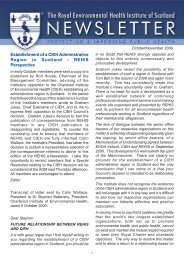Review of the Scottish Diet Action Plan - Food and Health Alliance
Review of the Scottish Diet Action Plan - Food and Health Alliance
Review of the Scottish Diet Action Plan - Food and Health Alliance
Create successful ePaper yourself
Turn your PDF publications into a flip-book with our unique Google optimized e-Paper software.
<strong>Review</strong> <strong>of</strong> <strong>the</strong> SDAP: Progress <strong>and</strong> Impacts 1996–2005<br />
confectionery in recent years. S<strong>of</strong>t drinks, confectionery <strong>and</strong> lager/beer are <strong>the</strong> three<br />
greatest contributors to sugar intakes.<br />
The panel considered a number <strong>of</strong> possible reasons why <strong>the</strong> dietary targets have not<br />
been met despite considerable success in implementing <strong>the</strong> SDAP recommendations.<br />
The most plausible explanations include:<br />
•<br />
•<br />
•<br />
•<br />
•<br />
•<br />
The direction required to achieve <strong>the</strong> level <strong>of</strong> change defined by <strong>the</strong> dietary targets<br />
underestimated <strong>the</strong> impact <strong>of</strong> inequalities.<br />
Resources <strong>and</strong> initiatives have been spread too thinly across a broad range <strong>of</strong><br />
actions ra<strong>the</strong>r than focusing on achieving population-level impact within a few<br />
priority areas.<br />
The broad range <strong>of</strong> actions recommended was not transparently or consistently<br />
linked to <strong>the</strong> narrow range <strong>of</strong> food <strong>and</strong> nutrient targets identified.<br />
The SDAP has adopted a wholly consensual partnership approach to ‘working<br />
with’ <strong>the</strong> food industry <strong>and</strong> thus underplayed <strong>the</strong> powerful role <strong>of</strong> <strong>the</strong> food supply<br />
chain in shaping food content, access, availability <strong>and</strong> consumer dem<strong>and</strong> over<br />
<strong>the</strong> last 10 years, such as <strong>the</strong> period <strong>of</strong> rapid restructuring <strong>of</strong> <strong>the</strong> food industry or<br />
<strong>the</strong> undermining <strong>of</strong> health messages by powerful marketing <strong>and</strong> advertising <strong>of</strong><br />
foods <strong>and</strong> drinks. The SDAP has not deployed <strong>the</strong> full set <strong>of</strong> policy tools available,<br />
most notably those <strong>of</strong> exercising regulatory <strong>and</strong> legislative powers <strong>of</strong> government<br />
to control <strong>the</strong> food supply chain <strong>and</strong> help create dem<strong>and</strong>.<br />
The areas where little or no progress has been made with implementation<br />
suggest that, until <strong>the</strong> recent public debate about rapidly rising obesity, <strong>the</strong> food<br />
supply chain has not been fully engaged with <strong>the</strong> need to change. Institutions<br />
<strong>and</strong> leadership across <strong>the</strong> supply chain have not been aligned effectively.<br />
At <strong>the</strong> regional level, SDAP implementation <strong>and</strong> prioritisation has appeared<br />
uneven, accountability for local implementation has not been clear <strong>and</strong> linkages<br />
with o<strong>the</strong>r relevant policy str<strong>and</strong>s have been inadequate.<br />
Each <strong>of</strong> <strong>the</strong> above reasons provides a plausible explanation for why <strong>the</strong> overall changes<br />
sought by <strong>the</strong> SDAP have not been achieved, although none alone is a sufficient<br />
explanation. There is no single, simple reason for <strong>the</strong> SDAP targets not being met.<br />
The panel concluded that, although some advances in thinking <strong>and</strong> practice have<br />
been made <strong>and</strong> some initiatives have been inspiring as well as effective, <strong>the</strong> total<br />
shift required <strong>and</strong> sought by <strong>the</strong> SDAP has not yet been realised. There are some<br />
important lessons for future policy:<br />
• To achieve population-level impact, a more focused <strong>and</strong> prioritised approach to<br />
policy <strong>and</strong> implementation may prove to be more effective than a broad range,<br />
or ‘scattergun’, <strong>of</strong> initiatives.<br />
• Given <strong>the</strong> complexity <strong>of</strong> modern food systems <strong>and</strong> <strong>the</strong>ir dynamics, action needs<br />
to be coordinated across all levels <strong>of</strong> food governance, from local to international<br />
level.<br />
• The actions need to be more plausibly linked to policy outcomes <strong>and</strong> targets<br />
<strong>and</strong> founded upon <strong>the</strong> overarching strategic <strong>the</strong>mes or ‘directions <strong>of</strong> travel’ with<br />
which all stakeholders (state, supply chain <strong>and</strong> consumers) can engage.<br />
• Lines <strong>of</strong> accountability, monitoring <strong>and</strong> performance reporting on policy<br />
implementation need to be improved, using a wider range <strong>of</strong> shared intermediate<br />
outcomes to help evaluate progress towards targets across sectors.<br />
• Greater use <strong>of</strong> regulatory powers <strong>and</strong> incentives can be appropriate <strong>and</strong> can<br />
be used to set goals for <strong>the</strong> food supply chain as well as help build consumer<br />
dem<strong>and</strong>.<br />
ix













